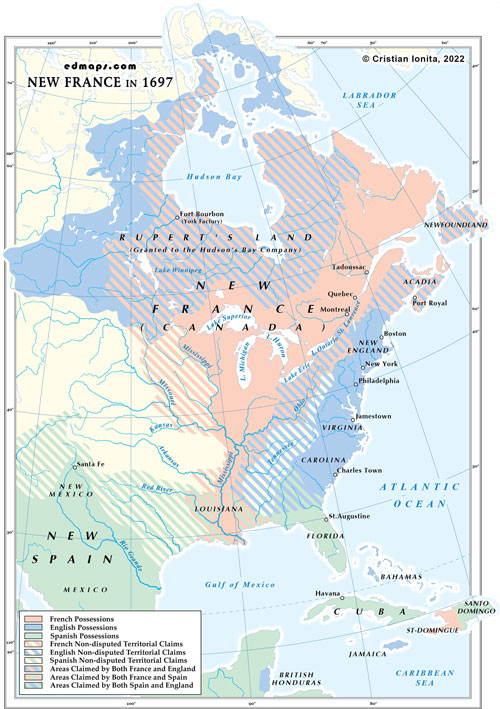New France in 1697


New France after the Treaty of Ryswick (1697)
The Treaty of Ryswick, signed in 1697, marked the end of the Nine Years' War (also known as the War of the League of Augsburg) and had major implications for New France.
Territorial Changes: The Treaty of Ryswick reaffirmed the status quo in North America, essentially returning the territorial boundaries of New France to what they were before the war. This meant that the French retained control over their existing colonial holdings.
Stabilization and Peace: The treaty brought a period of stability and relative peace to New France. With the cessation of hostilities, the colony could focus on consolidating its territories and developing its economy, particularly through the fur trade and the cultivation of land.
Fortifications and Defense: Following the treaty, New France invested in fortifications to defend its territories. Several forts and fortified posts were established or strengthened, especially along the St. Lawrence River and the Great Lakes region, to protect against potential English and Indigenous incursions.
Indigenous Relations: New France maintained complex relationships with Indigenous nations throughout its history. After the Treaty of Ryswick, efforts were made to solidify alliances and maintain friendly relations with Indigenous allies, such as the Huron-Wendat, Algonquin, and Montagnais, who played a vital role in the fur trade.
English Rivalry and Conflict: The Treaty of Ryswick did not resolve the underlying tensions and rivalries between New France and the English colonies to the south. The French and the English remained engaged in a struggle for dominance in North America, leading to subsequent conflicts, including Queen Anne's War (1702-1713) and the larger series of conflicts known as the French and Indian Wars.
Expanding French Presence: Despite ongoing conflicts, New France continued to expand its presence in North America. French explorers, fur traders, and settlers ventured into new regions, exploring the Mississippi River and establishing settlements in places like Mobile (in present-day Alabama) and New Orleans (in present-day Louisiana).
It is important to note that the Treaty of Ryswick did not mark the end of New France's history, and its colonial activities continued to evolve in the decades that followed, eventually culminating in the French and Indian War (1754-1763) and the subsequent transfer of New France to British control under the Treaty of Paris (1763).








